Jesse Floyd House at
Trubada
 It is being reported that the Glenville Inn on Route 5 is
located at Mudlick. That name is
historically incorrect. That
area of Route 5 has always been known as Trubada, pronounced, in the
Scotch-Irish manner as Trubadie. Mud
Lick (two words) is the creek, pronounced crick (for the same reason given
previously) above this site a road turns off Route 5 to the left and goes up
that hollow, pronounced holler, by all the pioneers who settled in the
Appalachian Mountains that run through West Virginia. That is Mud Lick.
It is being reported that the Glenville Inn on Route 5 is
located at Mudlick. That name is
historically incorrect. That
area of Route 5 has always been known as Trubada, pronounced, in the
Scotch-Irish manner as Trubadie. Mud
Lick (two words) is the creek, pronounced crick (for the same reason given
previously) above this site a road turns off Route 5 to the left and goes up
that hollow, pronounced holler, by all the pioneers who settled in the
Appalachian Mountains that run through West Virginia. That is Mud Lick.
When we say, “There’s a skiff of snow on the ground,”
it’s a light snow. Pronunciations
Such as whar (where), poosh (push), feesh (fish), backset (relapse) comes from
Elizabethan times. This language
was used by Chaucer, the Scots, the Irish and Shakespeare.
The language is archaic, but it is not incorrect, though English
teachers, labored long and hard to teach correct English usage and
pronunciation. I appreciate what
these devoted teachers did for all of us but I’m weary of my beloved West
Virginians being called “hillbillies”, when all they have been doing is
preserving the beauty and color of a long ago, almost lost language.
When the weather is really hot I say, “It’s hotter than the hinges of
hell.” When I’ve failed on my
first attempt I say, “I have to lick my calf over again.” A relative visiting with a spouse
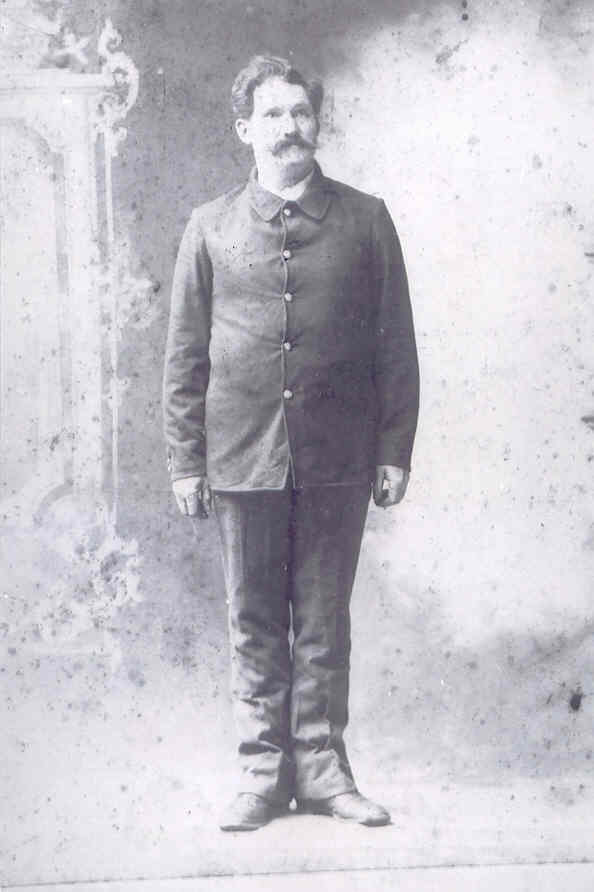 who had never been in the
area before was struck dumb by the word “berm” to him it had always been the
shoulder. When a person does not
carry his own weight we say, “He’s not worth powder and lead to blow his
brains out.” When asked if you’d like something, mountain people say,
“I don’t care of I do.” People unaccustomed to this response will pass you by because
they think you’ve answered in the negative.
Not so! Old people said,
when a married couple broke up; which wasn’t often, that “They were dividing
up the seed corn." There are
countless expressions such as these used by all us mountain people.
I ask you, isn’t it colorful? This language persisted in this
region mostly because the area reminded the people newly arrived of their home
across the sea, and partly because the terrain was so rugged they didn’t move
very much, thus their language, music, their culture, remained with them for
many many years after they settled in the mountains.
who had never been in the
area before was struck dumb by the word “berm” to him it had always been the
shoulder. When a person does not
carry his own weight we say, “He’s not worth powder and lead to blow his
brains out.” When asked if you’d like something, mountain people say,
“I don’t care of I do.” People unaccustomed to this response will pass you by because
they think you’ve answered in the negative.
Not so! Old people said,
when a married couple broke up; which wasn’t often, that “They were dividing
up the seed corn." There are
countless expressions such as these used by all us mountain people.
I ask you, isn’t it colorful? This language persisted in this
region mostly because the area reminded the people newly arrived of their home
across the sea, and partly because the terrain was so rugged they didn’t move
very much, thus their language, music, their culture, remained with them for
many many years after they settled in the mountains.
The Floyd’s were from Wales coming to this country in
1623. Much of the romantic Welsh
bard remained with them and their ways of making welcome all who came to their
door. The generosity of means and
spirit thrived in all of them.
The owners and contractors who are building on this site
are building on ground owned by my ancestors.
The house, built by Jesse L. and Eva Reed Floyd, Sr., was down the road
apiece almost directly across the road from the two brick houses on the left
side of the road. Our chicken house
was about where the first brick is and the barn was close to the second brick
only closer the road. The Glenville
Inn is in the area of the cornfield, though, as is all the property, greatly
raised above its’ original level. I
have often led horses, mules and mining ponies up the road and up Mud Lick to
water in the creek there.
Jesse L. Floyd, Sr.
(The house had gray siding and
striped awning across the front of the porch and hedges in front surrounded by
trees. The two windows on the
left were in mine and my sister, Linda’s bedroom.)

The house was built around the turn of the twentieth
century and it faced the river, as there were no roads.
The house was turned around after the road was built.
The two small windows, on the right of the upstairs, originally had been
a small porch, where they could sit and take in the breeze watching the
riverboats pass by. When they
turned the house around and put that siding on it, they closed up the porch and
removed all the ginger bread that had decorated it.
Zora Montgomery Lynch told me her grandfather Stephen Hugh Brady
Montgomery was the stonemason who cut the stone and laid the foundation for the
house.
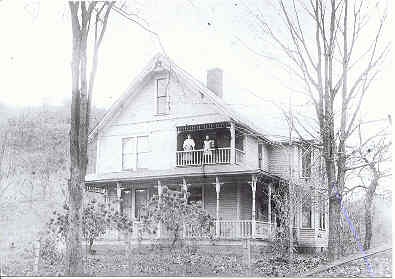 (On
the left, the two women on small porch: Eva Reed Floyd and Lucille Floyd Self)
(On
the left, the two women on small porch: Eva Reed Floyd and Lucille Floyd Self)
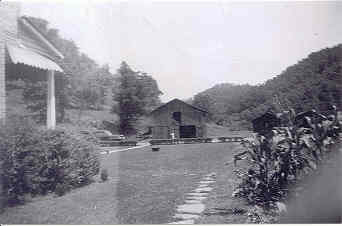
On the right, the picture of the barn directly across the road from the house about
in the middle of where the two brick houses are now on the left side of the road
going toward Sand Fork..)
My grandfather’s first wife was Angeletta Stout.
She was the mother of three of his sons: Ernest, Thomas and Duffy.
Ernest and Thomas were grown and gone when he married Eva Reed with Duffy
still at home. Grandmother Floyd recognizing Duffy’s intelligence saw to
it that he got an education. He
graduated from Glenville State College and WVU.
She bore a daughter, Lucille in 1901 and a son, Jesse Jr.,
in 1912. She had been the driving
force behind the building of the house, though the Floyd brothers needed little
to propel them to progress. Jesse’s
brother, James W. F. built the house on the Glenville side of Otterbein church,
which was rescued from the ashes by Howard and Pauline Sprouse Moffett and is
the present home of Lambert and Frances Peters Fitzwater and brother John built
a similar house at the head of Mud Lick. That
house was falling down when I was a kid in the 40’s and the James W. F. Floyd
house was in the process of falling down when Howard Moffett rescued it.
The Jesse L. Floyd Sr., house was really the best built and survived the
longest of the three. There may be
a reason for that which, if time and space permit, I will go into.
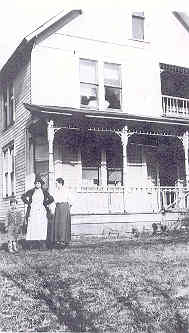 Picture
to the left: This is a picture of house as it looked when it was built.
Picture
to the left: This is a picture of house as it looked when it was built.
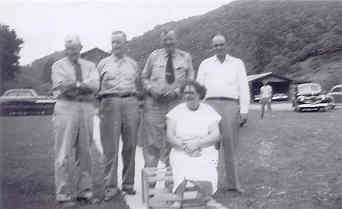
(Picture to the right:
Children
of Jesse L Floyd Sr., Ernest Floyd, Thomas Floyd, Duffy Floyd, Jesse Floyd, Jr.,
woman sitting in white Lucille Floyd Self. Picture was taken summer of 1948.
Uncle Ernest pulled an Airstream trailer all the way across
country from Escondido, CA. He and
Aunt Bertha Whiting Floyd stayed a month. This was a reunion that took place the
first summer my parents owned this property that had been their home.
Note the old cars and garage that is no longer there.
I believe the thin man in the background on the right is Bob Campbell
husband of Evelyn Self Campbell.)
My grandfather died of a cerebral hemorrhage.
He was struck down in the dining room and his blood stained the wooden
floor of that room in a puddle about the size of a large straw hat.
He died intestate – without a will.
The County Court of which my grandmother’s father, Lewis Reed and her
brother; at different times, Clacy Reed had been members, decided the fate of
the property in favor of the three older sons, granting my grandmother dower
rights to the property (until her death). Grandmother
was heard to remark, “There won’t be much left of it when I get done!”
So my Dad, Jesse, Jr., who was nine months old and Aunt Lucille who was
12 years old were left with nothing.
When my grandmother died in 1940 Uncle Duffy, also known as
C. D. Floyd, was determined his beloved sister, Aunt Lucille, would not be done
out of her home. He consulted with
his brothers and asked that they sign their share of the property over to her.
After all, she had made the home available to them when they wanted to
come for a visit. She had labored
long and hard to prepare rooms, beds and meals.
Her mother had encouraged him to get an education and without her he
probably wouldn’t have.
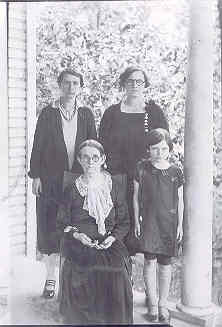
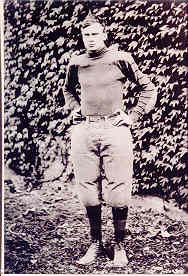 (Picture
to the left is of Uncle Duffy in WVU football uniform. Cec says it’s too bad he doesn’t have his leather helmet
with him in the picture.)
(Picture
to the left is of Uncle Duffy in WVU football uniform. Cec says it’s too bad he doesn’t have his leather helmet
with him in the picture.)
To make things legal he signed over his share of the
property for the sum of one dollar to her.
Uncle Thomas W. Floyd sold her his share of the property for one hundred
and fifty dollars. Uncle Ernest
sold her his share of the property to make it legal for the sum of one dollar
and herein lies the rub. Uncle
Ernest’s deed reads thusly: “…that
the home residence…………be repaired in a good workman-like manner, and be
kept continually in good repair so that it will not decrease in value, except
for the natural wear and tear of said residence building and failure on the part
of the said second party to do the things above set out, shall render this deed
null and void and the real estate herein conveyed shall revert back and become
the property of the said E.W. Floyd the same as if this deed had never been
made……..”This may explain why the house was so well kept for so many
years.
(The picture of the women on the right is: L-R
Grandmother Eva Reed Floyd and Aunt Lucille Floyd Self.
Sitting: Great Grandmother Joanna Goff Reed, girl to her right: First
Cousin Evelyn Self Campbell.)
Of course, the uncles passed on to their reward as did my
Dad and the only person likely to fight this thing in court, Uncle Ernest’s
son, E. Paul Floyd. I know that
Aunt Lucille and Uncle Matt Self sold the property to a Mr. Moore and his wife.
My Dad, Jesse L. Floyd, Jr., bought the property from them.
He put a bathroom in the house and had a lovely kitchen installed made of
knotty pine cabinets and a hutch. The
house had twelve foot ceilings with two mantels from floor to ceiling in the
dining and living rooms and four other mantels in four of the five bedrooms.
I always thought it was the strangest thing that the house had only three
closets upstairs and they were in the bedroom over the kitchen and one large
closet in the downstairs bedroom, with a rather large closet under the front
stairwell. These rooms were huge by
today’s standards. In fact, I learned to ride a small sidewalk bike in my
brother, Joe’s bedroom going ‘round and ‘round the bed catching the bed
when I went to fall over. There was
a large, open staircase that went up from the front hall and a small, enclosed
staircase that went up from the kitchen. It
was built that way for the cook, though no hired cook ever lived there.
Ray Helmick lived there when he worked for Dad in the mine.
There were two el shaped porches on the front and back Dad
taking the el of the back porch to make a bathroom and a small porch off the
other side of the kitchen. There
was a cellar-house solidly built the top used for storage and the bottom used
for canned goods, potatoes, apples and: another thing that fascinated me about
the house, at the end of the left wall was a wrought iron door with open work
allowing one to see in, or out, whatever the case might be with a small iron
lock. I’ve never known what that
was for. It was like a cell.
I don’t know if that was its’ use, for punishment perhaps of a slave
or a child, although there were never any slaves owned on this piece of Floyd
property.
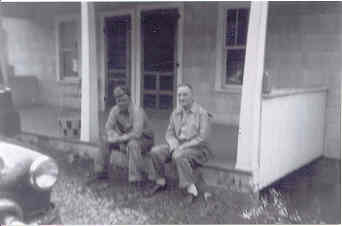
(Picture is of Jesse L. Floyd Jr., on the left and Uncle Tom Floyd on the right on
the small back porch off the kitchen after a hard days work at the mine.
We were often visited by the three older Floyd brothers.)
Behind and to the right of the cellar house were three
great, tall spindly trees and the ground was bare in a wide circle from the
trees. This was the spot where they
had built the fires under the huge kettles to do the wash or make apple butter.
The ground had never recovered from this abuse. On the right side of the house was the dug well.
I suppose we used the water out of that well, although I do not know for
sure. From where else would water
have come? At different spots
around the house were remnants of plants survived from my grandmother’s
plantings.
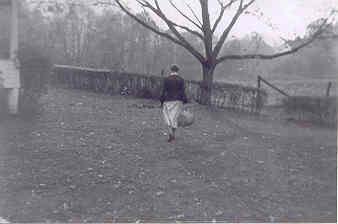 (Picture
to the right is of Aunt Lula Warner Floyd wife of Uncle Tom doing yard work.
Yard work was one of her pleasures having made practically a shrine of
the postage stamp sized yard at their home in Cleveland, OH.)
(Picture
to the right is of Aunt Lula Warner Floyd wife of Uncle Tom doing yard work.
Yard work was one of her pleasures having made practically a shrine of
the postage stamp sized yard at their home in Cleveland, OH.)
My first cousin, Evelyn Self Campbell said, when it was
being torn down, “I would like to have just a small piece of one of the boards
that had grandfather’s blood in it. Is
that sick?” “No,” I replied,
“I never thought of it, but I would have liked that, too.”
I would liked to have had one of the floor to ceiling mantels, though
I’ve no idea what I would have done with it.
I would liked to have had the huge foundation stones, but I’m not that
strong and would have had no way of getting them.
I believe we moved to this property in 1948.
It was the first house we ever lived in that had a bathroom and we got
our first television set. The TV
antenna was on top of the high hill across the road from the new Glenville Inn.
We often had to walk the line to keep leaves and branches off the line.
We named our new Collie puppy “Nidgie” after a Collie dog we saw on
the “Garry Moore Show”; through a lot of what we called “snow” in the
picture on the screen. Dad had to take that dog over the riverbank and shoot her
because Doc Matheney said she had cancer. Dad
came back to the house and cried.
There are many, many memories, some good, some bad.
Such is life. No matter how many bull dozers, or backhoes, or men with
grand ideas can destroy those. The
huge rocks up the road to the left at the entrance to Mud Lick make me wonder if
they are the same rocks we used to climb the hill with Jackie and Delores Lynch
to wonder at their size and puzzle as to how they got up there.
The marvels of nature are difficult to tame, as it seems some are
discovering to their peril.
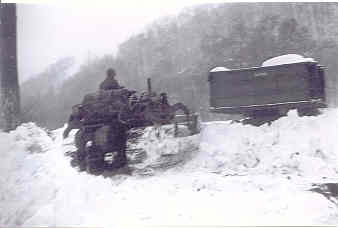
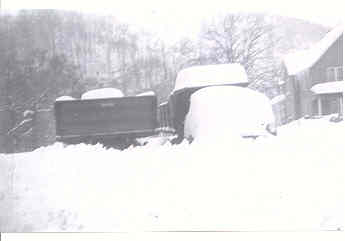
Talking about the
power of Mother Nature here are two pictures of the famous big snow of 1950 at
this property. The man on the
bulldozer is Gene Davis. I shoveled
the walk from the house to the road, a distance of about fifty feet.
I was about twelve years old. Can
you imagine a twelve year old doing that today.
A boy, let alone a girl.
Submitted for publication in the Glenville Alumni
Association Web site.
Patty Floyd
Johnson
 It is being reported that the Glenville Inn on Route 5 is
located at Mudlick. That name is
historically incorrect. That
area of Route 5 has always been known as Trubada, pronounced, in the
Scotch-Irish manner as Trubadie. Mud
Lick (two words) is the creek, pronounced crick (for the same reason given
previously) above this site a road turns off Route 5 to the left and goes up
that hollow, pronounced holler, by all the pioneers who settled in the
Appalachian Mountains that run through West Virginia. That is Mud Lick.
It is being reported that the Glenville Inn on Route 5 is
located at Mudlick. That name is
historically incorrect. That
area of Route 5 has always been known as Trubada, pronounced, in the
Scotch-Irish manner as Trubadie. Mud
Lick (two words) is the creek, pronounced crick (for the same reason given
previously) above this site a road turns off Route 5 to the left and goes up
that hollow, pronounced holler, by all the pioneers who settled in the
Appalachian Mountains that run through West Virginia. That is Mud Lick. 










